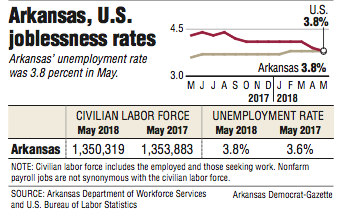Arkansas' unemployment rate held steady at 3.8 percent in May, the U.S. Bureau of Labor Statistics said Friday.
The national unemployment rate was also 3.8 percent in May.
The state's unemployment rate has been below 4 percent since July 2016, falling as low as 3.6 percent in February, March, April and May last year.
There were a couple of encouraging signs in the employment report, said Michael Pakko, chief economist for the Arkansas Economic Development Institute at the University of Arkansas at Little Rock.
One was that the number of unemployed Arkansans, which has been rising in recent months, dropped by 419, Pakko said.
Another good sign was that the number of manufacturing jobs grew by 4,100 in May compared with May last year, Pakko said. That was the biggest jump of any of the 11 industry sectors in Arkansas.
There were 160,300 manufacturing jobs in May.
For years, manufacturing had the worst performance of the sectors. Manufacturing employment peaked at 247,300 jobs in Arkansas in early 1995 and still had more than 200,000 jobs in 2006.
But there also seems to be clear signs of weakening in the report, Pakko said.
"We have been seeing several months of decline in employment," Pakko said.
The number of employed Arkansans was 1,299,095 in May, the first time it has dropped below 1.3 million since March last year.
And the civilian labor force -- the combination of employed Arkansans and unemployed Arkansans looking for work -- dropped by almost 7,600 in the past nine months.
Before that, from March 2017 to September 2017, the labor force grew by 7,325. Arkansas had 1,350,319 in the labor force in May.
Arkansas' unemployment rate was better than most of its adjacent states, said Greg Kaza, executive director of the Arkansas Policy Foundation in Little Rock.
Only Tennessee, at 3.5 percent, and Missouri, at 3.6 percent, had unemployment rates better than Arkansas, Kaza said. Oklahoma had a 4.0 percent unemployment rate in May, followed by Texas with 4.1 percent, Louisiana with 4.6 percent and Mississippi at 4.7 percent.
Arkansas' labor force participation rate continues to decline, said Mervin Jebaraj, director of the Center for Business and Economic Research at the University of Arkansas in Fayetteville.
The labor force participation rate is the percentage of the population from ages 16 to 64 that is working or seeking work. Most states have labor force participation rates above 60 percent, Jebaraj said.
"[Arkansas'] labor force participation rate has been declining by about 0.1 percent every month," Jebaraj said. "I used to complain that it was at 58 percent. Now it's at [about] 57 percent."
The state added about 6,500 jobs from May last year to May this year, Jebaraj said.
But looking at the job growth by metropolitan areas gives a much more troubling picture.
"Rural areas in Arkansas lost a lot of jobs," Jebaraj said.
The six metropolitan areas in the state added a net total of 12,400 jobs from May to May, Jebaraj said.
That means that outside the metropolitan areas of the state, the remainder of the state lost almost 6,000 jobs, Jebaraj said.
Six industry sectors reported gains in employment in Arkansas in May and five were down.
The construction sector lost 400 jobs in Arkansas in the past year, which is in contrast to the construction industry nationally where 42 states reported job growth from May 2017 to May this year, according to the Associated General Contractors of America.
Construction reached a record high in Louisiana, Nebraska and Texas, and eight states added more than 10,000 construction jobs since May last year, the contractors association said.
"Arkansas shows quite a bit of volatility in the year-over-year change [in construction employment]," said Kenneth Simonson, chief economist for the Associated General Contractors of America. "Such volatility is not surprising in a state with relatively small construction employment [0.7 percent of the U.S. total]. The start or completion of one very large project can cause quite a swing."
The country as a whole had construction employment gains of 2 to 4 percent for the past few years, Simonson said.
Hawaii had the lowest unemployment rate in May at 2.0 percent, followed by North Dakota at 2.6 percent, Iowa and New Hampshire at 2.7 percent each and Colorado, Maine, Nebraska, Vermont and Wisconsin at 2.8 percent each.
Alaska had the highest rate at 7.2 percent, followed by West Virginia at 5.4 percent, New Mexico at 5.1 percent, Nevada at 4.8 percent and Arizona, Mississippi and Washington at 4.7 percent each.
Business on 06/16/2018
